When you switch on or connect a device, electric current flows through its circuit. At this point, it’s a marathon; the electrons are literally racing to get to the finishing line.


If this uncontrolled marathon of current flow continues, it can result in following outcomes:
- Damage to sensitive electronic circuits, leading to malfunctions or complete failure.
- Component failure due to the stress of carrying too much current beyond their rated capacity.
- Components can overheat, potentially damaging them or even causing them to catch fire.
- High current levels pose safety risks, such as electrical shocks and fires.
We can see that uncontrolled current is definitely not a good thing. This is where resistors come to the rescue.
Today, we’ll be looking at the concept of resistance, types of resistors, the colour code system, and how to choose the right resistor for a project.
Resistors and Resistance
Resistance is the restriction of the flow of electrons and is therefore the antithesis of current. Think of a fast-moving car on a freeway. When it meets a rump, it’ll have to slow down. If there are many rumps on the road, the car will slow down considerably. Likewise, if the resistance in a circuit increases, the current will decrease.
A resistor is the device that produces resistance. Resistors are like the chill referees of the electronics world, keeping everything in check and preventing electrical chaos from taking over!
Types of Resistors
There are two main types of resistors: fixed and variable.
A fixed resistor has fixed resistance values at all times that cannot be varied or adjusted. They are available in a wide range of varying resistances.
When it is necessary to adjust the resistance, a variable resistor is used. Variable resistors serve two main functions: as potentiometers and rheostats. A potentiometer is a 3-terminal variable resistor used to manually adjust resistance to control the flow of electric current. A rheostat is a variable resistor that adjusts its resistance by altering the current passing through a circuit. It effectively controls current without interrupting the circuit’s flow.
Colour Code
The color code is used to indicate the value or magnitude of the resistance of a resistor. It is possible to determine the value of resistance by identifying the band colors and then looking up the corresponding values on a colour code chart.
Before we look at the colour code chart, let’s look at a few terminologies we’ll be using.
- Significant figures: These are digits or numbers with values in ohms corresponding to the band colours.
- Multiplier: This will shift the decimal place of the resistance value gained from the significant figures.
- Tolerance: This refers to the percentage of deviation in a resistor’s resistance, indicating how much more or less the actual measured resistance value differs from the stated value.
- Temperature coefficient: It indicates how much the resistance value of the resistor will change with respect to changes in temperature.
Now to the colour code chart…
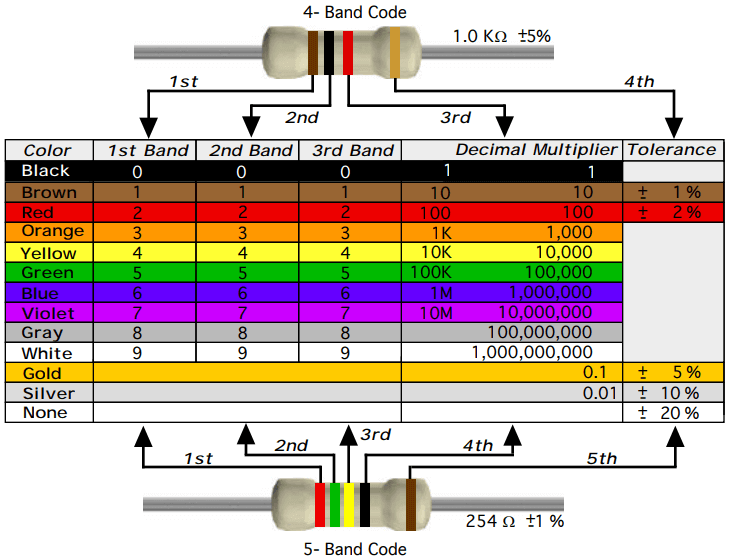
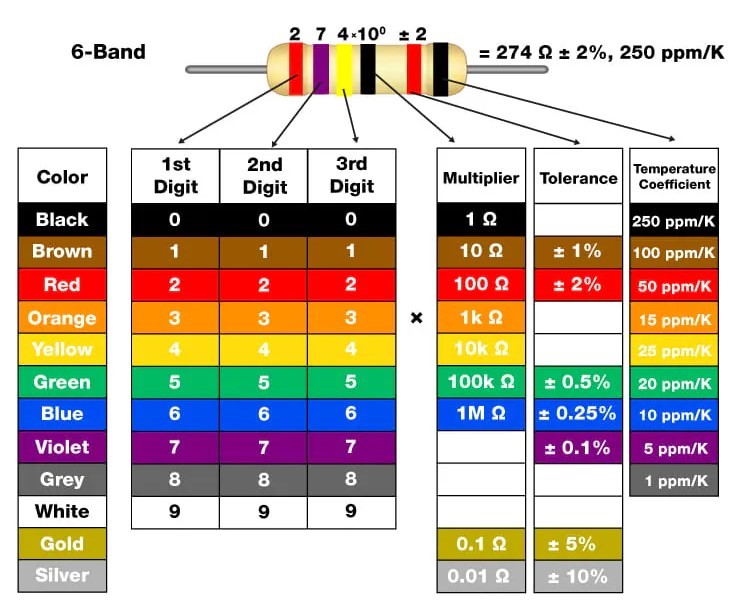
In a 4-band resistor, the first two bands represent the significant figures; the third band indicates the multiplier; and the fourth band indicates the tolerance.
In a 5-band resistor, the first three bands represent the significant figures; the fourth band indicates the multiplier; and the fifth band indicates the tolerance.
In a 6-band resistor, the first three bands represent the significant figures; the fourth band indicates the multiplier; the fifth band indicates the tolerance; and the sixth band represents the temperature coefficient.
Reading the colour code chart
The 4-band colour code is the most common variation of resistors. In reading its colour code chart,
- Begin with the end that has the most bands. A space between the third and fourth bands also indicates the reading direction.
- The first colour represents the first digit of the value.
- The second colour is the second digit of the value.
- The first and second digits are multiplied by the multiplier value of the third colour.
- The fourth colour gives the tolerance value in percentage. If a fourth band does not exist, then the tolerance would be 20%.
For example:
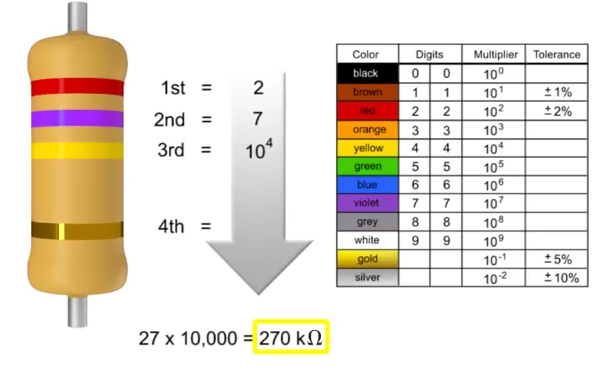
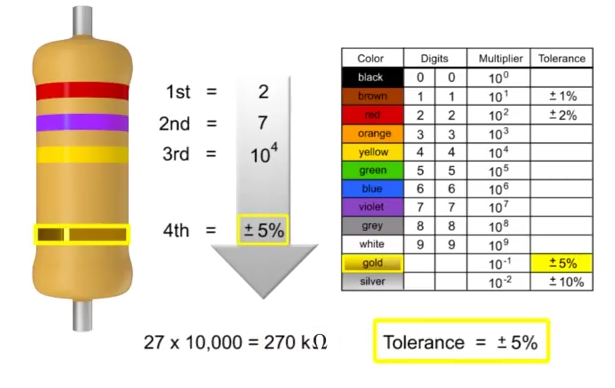
- Beginning with the end that has the most colour bands, red is the first, with a corresponding value of 2. The second colour is violet, and the corresponding digit is 7. So the resistance value becomes 27Ω.
- The third colour is yellow. The corresponding multiplier value is 104 or 10K. We multiply the resistance value of 27Ω by 10,000 (10K), resulting in a total resistance value of 270KΩ.
- The fourth colour is gold. The corresponding tolerance value is ±5%. This means that there is a 5% deviation from the actual resistance value, either more than or less than.
Choosing the right resistor
In choosing the right resistor for your project,
- Determine the required resistance. To do that, you use Ohm’s law.
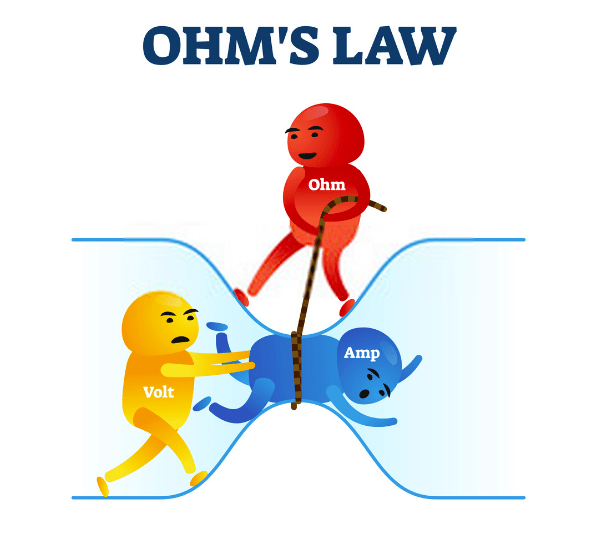

- Next, calculate the power that the resistor will need to dissipate to determine the required power rating for the resistor. This can be done using the formula;

where P is the Power (in Watt), V is the Voltage (in Volts), and R is the Resistance (in Ohms)
A rule of thumb is to find a resistor with twice the required power rating.
- After finding the appropriate resistance value and power rating, you can then choose the type of resistor you want. There are different types of fixed resistors available on the market. These include carbon composition resistors, carbon film resistors, metal film resistors, metal glaze resistors, etc.
ACL offers resistors with a variety of resistance values. You can visit our site to look them up.
That’s all for today. If you have any question or comments, feel free to do so in the comment section below.
Until next time, keep exploring.



